 Tesseract | 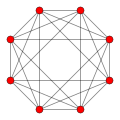 16-cell |
In 4-dimensional geometry, there are 15 uniform 4-polytopes with B4 symmetry. There are two regular forms, the tesseract and 16-cell, with 16 and 8 vertices respectively.
 Tesseract |  16-cell |
In 4-dimensional geometry, there are 15 uniform 4-polytopes with B4 symmetry. There are two regular forms, the tesseract and 16-cell, with 16 and 8 vertices respectively.
They can be visualized as symmetric orthographic projections in Coxeter planes of the B5 Coxeter group, and other subgroups.
Symmetric orthographic projections of these 32 polytopes can be made in the B5, B4, B3, B2, A3, Coxeter planes. Ak has [k+1] symmetry, and Bk has [2k] symmetry.
These 32 polytopes are each shown in these 5 symmetry planes, with vertices and edges drawn, and vertices colored by the number of overlapping vertices in each projective position.
The pictures are drawn as Schlegel diagram perspective projections, centered on the cell at pos. 3, with a consistent orientation, and the 16 cells at position 0 are shown solid, alternately colored.
| # | Name | Coxeter plane projections | Schlegel diagrams | Net | ||||
|---|---|---|---|---|---|---|---|---|
| B4 [8] | B3 [6] | B2 [4] | A3 [4] | Cube centered | Tetrahedron centered | |||
| 1 | 8-cell or tesseract |  |  |  |  |  |  | |
| 2 | rectified 8-cell |  |  |  |  |  |  | |
| 3 | 16-cell |  |  |  |  |  |  | |
| 4 | truncated 8-cell |  |  |  |  |  |  | |
| 5 | cantellated 8-cell |  |  |  |  |  |  | |
| 6 | runcinated 8-cell (also runcinated 16-cell) |  |  |  |  |  |  |  |
| 7 | bitruncated 8-cell (also bitruncated 16-cell) |  |  |  |  |  |  |  |
| 8 | truncated 16-cell |  |  |  |  |  |  | |
| 9 | cantitruncated 8-cell |  |  |  |  |  |  | |
| 10 | runcitruncated 8-cell |  |  |  |  |  |  | |
| 11 | runcitruncated 16-cell |  |  |  |  |  |  | |
| 12 | omnitruncated 8-cell (also omnitruncated 16-cell) |  |  |  |  |  |  |  |
| # | Name | Coxeter plane projections | Schlegel diagrams | Net | |||||
|---|---|---|---|---|---|---|---|---|---|
| F4 [12] | B4 [8] | B3 [6] | B2 [4] | A3 [4] | Cube centered | Tetrahedron centered | |||
| 13 | *rectified 16-cell (Same as 24-cell ) r{3,3,4} = {3,4,3} |  |  |  |  |  |  |  | |
| 14 | *cantellated 16-cell (Same as rectified 24-cell ) rr{3,3,4} = r{3,4,3} |  |  |  |  |  |  |  | |
| 15 | *cantitruncated 16-cell (Same as truncated 24-cell ) tr{3,3,4} = t{3,4,3} |  |  |  |  |  |  |  | |
| # | Name | Coxeter plane projections | Schlegel diagrams | Net | |||||
|---|---|---|---|---|---|---|---|---|---|
| F4 [12] | B4 [8] | B3 [6] | B2 [4] | A3 [4] | Cube centered | Tetrahedron centered | |||
| 16 | alternated cantitruncated 16-cell (Same as the snub 24-cell) sr{3,3,4} = s{3,4,3} |  |  |  |  |  |  | ||
The tesseractic family of 4-polytopes are given by the convex hulls of the base points listed in the following table, with all permutations of coordinates and sign taken. Each base point generates a distinct uniform 4-polytopes. All coordinates correspond with uniform 4-polytopes of edge length 2.
| # | Base point | Name | Coxeter diagram | Vertices | |
|---|---|---|---|---|---|
| 3 | (0,0,0,1)√2 | 16-cell | 8 | 24-34!/3! | |
| 1 | (1,1,1,1) | Tesseract | 16 | 244!/4! | |
| 13 | (0,0,1,1)√2 | Rectified 16-cell (24-cell) | 24 | 24-24!/(2!2!) | |
| 2 | (0,1,1,1)√2 | Rectified tesseract | 32 | 244!/(3!2!) | |
| 8 | (0,0,1,2)√2 | Truncated 16-cell | 48 | 24-24!/2! | |
| 6 | (1,1,1,1) + (0,0,0,1)√2 | Runcinated tesseract | 64 | 244!/3! | |
| 4 | (1,1,1,1) + (0,1,1,1)√2 | Truncated tesseract | 64 | 244!/3! | |
| 14 | (0,1,1,2)√2 | Cantellated 16-cell (rectified 24-cell) | 96 | 244!/(2!2!) | |
| 7 | (0,1,2,2)√2 | Bitruncated 16-cell | 96 | 244!/(2!2!) | |
| 5 | (1,1,1,1) + (0,0,1,1)√2 | Cantellated tesseract | 96 | 244!/(2!2!) | |
| 15 | (0,1,2,3)√2 | cantitruncated 16-cell (truncated 24-cell) | 192 | 244!/2! | |
| 11 | (1,1,1,1) + (0,0,1,2)√2 | Runcitruncated 16-cell | 192 | 244!/2! | |
| 10 | (1,1,1,1) + (0,1,1,2)√2 | Runcitruncated tesseract | 192 | 244!/2! | |
| 9 | (1,1,1,1) + (0,1,2,2)√2 | Cantitruncated tesseract | 192 | 244!/2! | |
| 12 | (1,1,1,1) + (0,1,2,3)√2 | Omnitruncated 16-cell | 384 | 244! | |

In four-dimensional geometry, a cantellated tesseract is a convex uniform 4-polytope, being a cantellation of the regular tesseract.
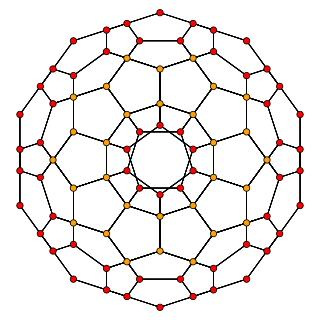
In four-dimensional geometry, a runcinated 120-cell is a convex uniform 4-polytope, being a runcination of the regular 120-cell.
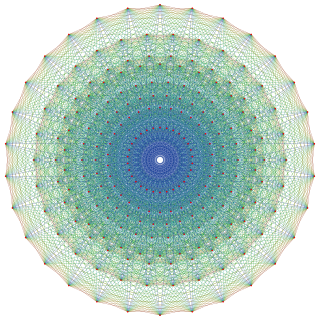
In 8-dimensional geometry, there are 255 uniform polytopes with E8 symmetry. The three simplest forms are the 421, 241, and 142 polytopes, composed of 240, 2160 and 17280 vertices respectively.

In 7-dimensional geometry, there are 127 uniform polytopes with E7 symmetry. The three simplest forms are the 321, 231, and 132 polytopes, composed of 56, 126, and 576 vertices respectively.

In 6-dimensional geometry, there are 39 uniform polytopes with E6 symmetry. The two simplest forms are the 221 and 122 polytopes, composed of 27 and 72 vertices respectively.
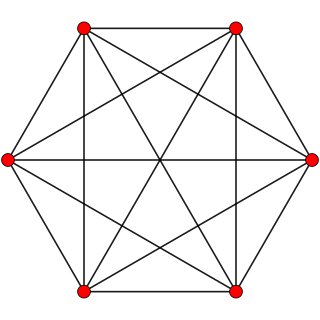
In five-dimensional geometry, a truncated 5-simplex is a convex uniform 5-polytope, being a truncation of the regular 5-simplex.
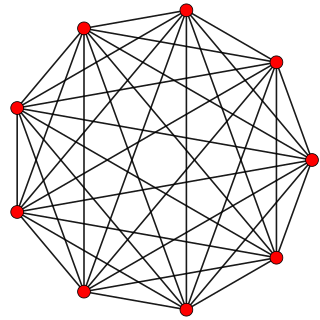
In 8-dimensional geometry, there are 135 uniform polytopes with A8 symmetry. There is one self-dual regular form, the 8-simplex with 9 vertices.

In 7-dimensional geometry, there are 128 uniform polytopes with B7 symmetry. There are two regular forms, the 7-orthoplex, and 8-cube with 14 and 128 vertices respectively. The 7-demicube is added with half of the symmetry.

In 7-dimensional geometry, there are 71 uniform polytopes with A7 symmetry. There is one self-dual regular form, the 7-simplex with 8 vertices.
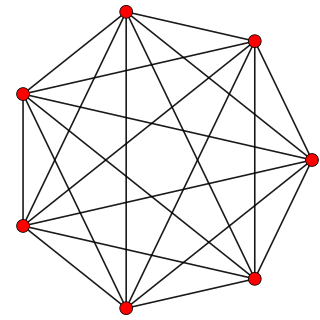
In 6-dimensional geometry, there are 35 uniform polytopes with A6 symmetry. There is one self-dual regular form, the 6-simplex with 7 vertices.

In 6-dimensional geometry, there are 64 uniform polytopes with B6 symmetry. There are two regular forms, the 6-orthoplex, and 6-cube with 12 and 64 vertices respectively. The 6-demicube is added with half the symmetry.

In 6-dimensional geometry, there are 47 uniform polytopes with D6 symmetry, 16 are unique, and 31 are shared with the B6 symmetry. There are two regular forms, the 6-orthoplex, and 6-demicube with 12 and 32 vertices respectively.
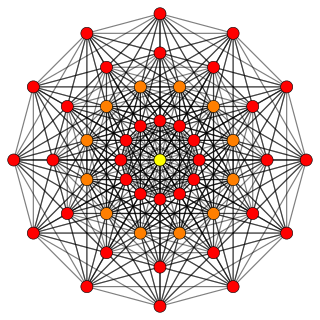
In 7-dimensional geometry, there are 95 uniform polytopes with D7 symmetry; 32 are unique, and 63 are shared with the B7 symmetry. There are two regular forms, the 7-orthoplex, and 7-demicube with 14 and 64 vertices respectively.

In 5-dimensional geometry, there are 19 uniform polytopes with A5 symmetry. There is one self-dual regular form, the 5-simplex with 6 vertices.

In 5-dimensional geometry, there are 31 uniform polytopes with B5 symmetry. There are two regular forms, the 5-orthoplex, and 5-cube with 10 and 32 vertices respectively. The 5-demicube is added as an alternation of the 5-cube.

In 5-dimensional geometry, there are 23 uniform polytopes with D5 symmetry, 8 are unique, and 15 are shared with the B5 symmetry. There are two special forms, the 5-orthoplex, and 5-demicube with 10 and 16 vertices respectively.

In 4-dimensional geometry, there are 9 uniform polytopes with A4 symmetry. There is one self-dual regular form, the 5-cell with 5 vertices.

In 4-dimensional geometry, there are 15 uniform polytopes with H4 symmetry. Two of these, the 120-cell and 600-cell, are regular.
In 4-dimensional geometry, there are 7 uniform 4-polytopes with reflections of D4 symmetry, all are shared with higher symmetry constructions in the B4 or F4 symmetry families. there is also one half symmetry alternation, the snub 24-cell.